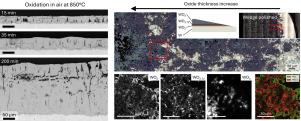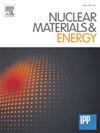Understanding the oxidation of pure tungsten in air and its impact on the lifecycle of a fusion power plant
IF 2.7
2区 物理与天体物理
Q1 NUCLEAR SCIENCE & TECHNOLOGY
引用次数: 0
Abstract
The oxidation of pure W and the sublimation of W oxide have been investigated to assess their impact on the lifecycle of a fusion power plant. Pure W has been oxidised at temperatures between 400 and 1050 °C and for durations ranging between 1 and 70 h. The formation of voids and cracks has been observed at temperatures above 600 °C, leading to the formation of dust or oxide spalling, which could be problematic in maintenance and waste-handling scenarios of a fusion power plant. Preferential oxidation taking place at the edge of the specimen was characterised, and its impact is discussed in relation to component design. Characterisation using electron microscopy and Raman spectroscopy revealed that the oxide scale is formed of three main layers: the inner layer is 30–50 nm thick WO oxide, the middle layer is a 10–20 m thick of WO2.72 and the outer layer is formed of WO2.9/WO phases — whose thickness varies according to the total thickness of the oxide scale. The observed microstructure is discussed in relation to the parabolic-to-linear kinetics and its potential impact on tritium permeation and detritiation efficiency.

了解纯钨在空气中的氧化及其对核聚变电厂生命周期的影响
研究了纯W的氧化和W氧化物的升华,以评估它们对核聚变电厂生命周期的影响。纯W在400至1050°C的温度下氧化,持续时间在1至70小时之间。在600°C以上的温度下观察到空洞和裂纹的形成,导致灰尘或氧化物剥落的形成,这可能会在核聚变发电厂的维护和废物处理场景中产生问题。优先氧化发生在试样的边缘进行了表征,并讨论了其影响有关的组件设计。利用电子显微镜和拉曼光谱对氧化层进行了表征,发现氧化层主要由三层组成:内层为30 ~ 50 nm厚的WO2氧化物,中间层为10 ~ 20 μm厚的WO2.72,外层为WO2.9/WO3相,其厚度根据氧化层的总厚度而变化。讨论了观察到的微观结构与抛物线-线性动力学的关系及其对氚渗透和除氚效率的潜在影响。
本文章由计算机程序翻译,如有差异,请以英文原文为准。
求助全文
约1分钟内获得全文
求助全文
来源期刊

Nuclear Materials and Energy
Materials Science-Materials Science (miscellaneous)
CiteScore
3.70
自引率
15.40%
发文量
175
审稿时长
20 weeks
期刊介绍:
The open-access journal Nuclear Materials and Energy is devoted to the growing field of research for material application in the production of nuclear energy. Nuclear Materials and Energy publishes original research articles of up to 6 pages in length.
 求助内容:
求助内容: 应助结果提醒方式:
应助结果提醒方式:


